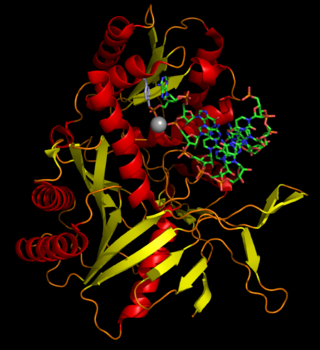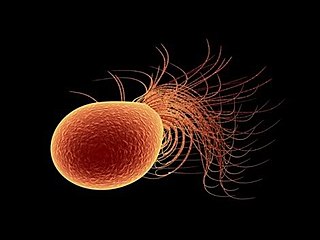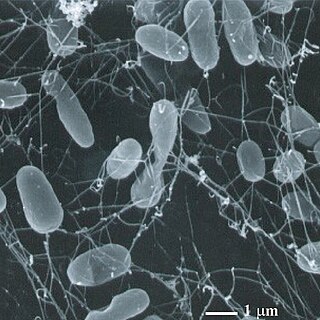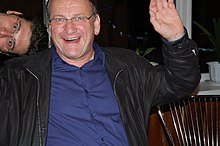
Nanoarchaeota is a proposed phylum in the domain Archaea that currently has only one representative, Nanoarchaeum equitans, which was discovered in a submarine hydrothermal vent and first described in 2002.
The Aquificota phylum is a diverse collection of bacteria that live in harsh environmental settings. The name Aquificota was given to this phylum based on an early genus identified within this group, Aquifex, which is able to produce water by oxidizing hydrogen. They have been found in springs, pools, and oceans. They are autotrophs, and are the primary carbon fixers in their environments. These bacteria are Gram-negative, non-spore-forming rods. They are true bacteria as opposed to the other inhabitants of extreme environments, the Archaea.
A hyperthermophile is an organism that thrives in extremely hot environments—from 60 °C (140 °F) upwards. An optimal temperature for the existence of hyperthermophiles is often above 80 °C (176 °F). Hyperthermophiles are often within the domain Archaea, although some bacteria are also able to tolerate extreme temperatures. Some of these bacteria are able to live at temperatures greater than 100 °C, deep in the ocean where high pressures increase the boiling point of water. Many hyperthermophiles are also able to withstand other environmental extremes, such as high acidity or high radiation levels. Hyperthermophiles are a subset of extremophiles. Their existence may support the possibility of extraterrestrial life, showing that life can thrive in environmental extremes.

Archaeoglobaceae are a family of the Archaeoglobales. All known genera within the Archaeoglobaceae are hyperthermophilic and can be found near undersea hydrothermal vents. Archaeoglobaceae are the only family in the order Archaeoglobales, which is the only order in the class Archaeoglobi.
Ferroglobus is a genus of the Archaeoglobaceae.
The Thermotogota are a phylum of the domain Bacteria. The phylum Thermotogota is composed of Gram-negative staining, anaerobic, and mostly thermophilic and hyperthermophilic bacteria.

The University of Regensburg is a public research university located in the medieval city of Regensburg, Bavaria, a city that is listed as a UNESCO World Heritage Site. The university was founded on 18 July 1962 by the Landtag of Bavaria as the fourth full-fledged university in Bavaria. Following groundbreaking in 1965, the university officially opened to students during the 1967–1968 winter semester, initially housing faculties in Law and Business Sciences and Philosophy. During the summer semester of 1968 the faculty of Theology was created. Currently, the University of Regensburg houses eleven faculties.
Aquifex is a bacterial genus, belonging to phylum Aquificota. There is one species of Aquifex with a validly published name – A. pyrophilus – but "A. aeolicus" is sometimes considered as species though it has no standing as a name given it has not been validly or effectively published. Aquifex spp. are extreme thermophiles, growing best at temperature of 85 °C to 95 °C. They are members of the Bacteria as opposed to the other inhabitants of extreme environments, the Archaea.
"Aquifex aeolicus" is a chemolithoautotrophic, Gram-negative, motile, hyperthermophilic bacterium. "A. aeolicus" is generally rod-shaped with an approximate length of 2.0-6.0μm and a diameter of 0.4-0.5μm. "A. aeolicus" is neither validly nor effectively published and, having no standing in nomenclature, should be styled in quotation marks. It is one of a handful of species in the Aquificota phylum, an unusual group of thermophilic bacteria that are thought to be some of the oldest species of bacteria, related to filamentous bacteria first observed at the turn of the century. "A. aeolicus" is also believed to be one of the earliest diverging species of thermophilic bacteria. "A. aeolicus" grows best in water between 85 °C and 95 °C, and can be found near underwater volcanoes or hot springs. It requires oxygen to survive but has been found to grow optimally under microaerophilic conditions. Due to its high stability against high temperature and lack of oxygen, "A. aeolicus" is a good candidate for biotechnological applications as it is believed to have potential to be used as hydrogenases in an attractive H2/O2 biofuel cell, replacing chemical catalysts. This can be useful for improving industrial processes.
Aquifex pyrophilus is a gram-negative, non-spore forming, rod-shaped bacteria. It is one of a handful of species in the Aquificota phylum, which are a group of thermophilic bacteria that are found near underwater volcanoes or hot springs.

Pyrococcus furiosus is a heterotrophic, strictly anaerobic, extremophilic, model species of archaea. It is classified as a hyperthermophile because it thrives best under extremely high temperatures, and is notable for having an optimum growth temperature of 100 °C. P. furiosus belongs to the Pyrococcus genus, most commonly found in extreme environmental conditions of hydrothermal vents. It is one of the few prokaryotic organisms that has enzymes containing tungsten, an element rarely found in biological molecules.
Caldococcus is a genus of Archaea in the order Desulfurococcales.

Pyrolobus fumarii is a species of archaea known for its live and reproduction at extremely high temperatures that kill most organisms. P. fumarii is known as a hyperthermophile obligately chemolithoautotroph. In the simplest terms, this archaea grows best in warm temperatures ranging from 80 °C to 115 °C. It also uses preformed molecules as its energy source rather than light, inorganic as an electron donor, and CO2 is used as a carbon source. It was first discovered in 1997 in a black smoker hydrothermal vent at the Mid-Atlantic Ridge, setting the upper-temperature threshold for known life to exist at 113 °C (235.4 °F) with an optimal temperature of 106 °C. This species "freezes" or solidifies and ceases growth at temperatures of 90 °C (194 °F) and below.

Archaea is a domain of single-celled organisms. These microorganisms lack cell nuclei and are therefore prokaryotes. Archaea were initially classified as bacteria, receiving the name archaebacteria, but this term has fallen out of use.
An extremozyme is an enzyme, often created by archaea, which are known prokaryotic extremophiles that can function under extreme environments. Examples of such are those in highly acidic/basic conditions, high/low temperatures, high salinity, or other factors, that would otherwise denature typical enzymes. This feature makes these enzymes of interest in a variety of hassan biotechnical applications in the energy, pharmaceutical, agricultural, environmental, food, health, and textile industries.

Thermococcus gammatolerans is an archaea extremophile and the most radiation-resistant organism known to exist.

David Prangishvili is a virologist, Professor at the Pasteur Institute of Paris, and foremost authority on viruses infecting Archaea.

Otto Kandler was a German botanist and microbiologist. Until his retirement in 1986 he was professor of botany at the Ludwig Maximilian University of Munich.
Saccharolobus solfataricus is a species of thermophilic archaeon. It was transferred from the genus Sulfolobus to the new genus Saccharolobus with the description of Saccharolobus caldissimus in 2018.

The Kolbeinsey Ridge is a segment of the Mid-Atlantic Ridge located to the north of Iceland in the Arctic Ocean. It is bounded to the south by the Tjörnes Fracture Zone, which connects the submarine ridge to the on-shore Northern Volcanic Zone rifting center in eastern Iceland. The volcanic islands Kolbeinsey and Grímsey lie along the Kolbeinsey Ridge.










